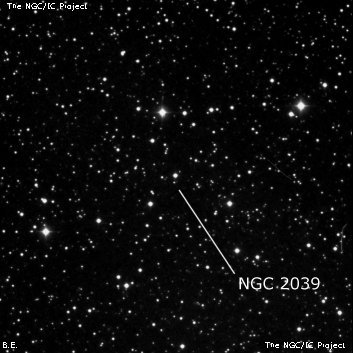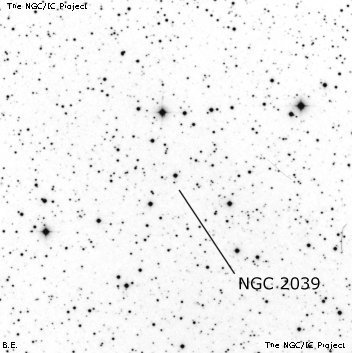NGC/IC Project Restoration Effort
(This is a very very beta version)
NGC2039


Basic Information
Location and Magnitude
Right Ascension: 5:44:1.0
Declination: +8:41:30
Constellation: ORI
Visual Magnitude:
Historic Information
Discoverer: Herschel J.
Year of discovery: 1828
Discovery aperture: 18.3
Observational
Summary description: Cl, vL, lRi, lC
Sub-type: *Grp
Corwin's Notes
=====
NGC 2039 (= h 366) was described by JH as "A large tract of stars filling
many fields. It extends much further in RA." He has a second concordant
observation: "A large ill-defined tract of loose stars, neither rich nor
condensed," though for this one, he made an estimate of only the NPD.
Just such a configuration, roughly 30 arcmin across in RA and 10 arcmin in
Dec, is centered two or three arcmin north-northwest of JH's single position.
It is a well-scattered group of about 30 stars ranging in magnitude from 8 to
13. I doubt very much that it is a true cluster.
However, JH called this H VIII 2 in both observations in his 1833 catalogue.
That this is probably not the case was realized by JH himself as H VIII 2 (NGC
2063, which see) and h 366 were given separate GC numbers. WH described his
object as "A small cluster of very small scattered stars" and gave it a
position (from two observations) nearly 3 minutes of time following and 8
arcmin north of JH's later position for h 366.
Dreyer followed GC, but neither he nor JH mention the initial confusion of the
two objects.
Looking at this again early in 2014, I would make the position of the center
of the asterism about half a minute of time further west, and a bit south, of
JH's position. It does stretch out in RA quite a bit. I also noticed that
Brent Archinal puts the center another 1.7 minutes of time east. This RA ends
up in a pretty empty space east of the brighter stars that apparently make up
JH's cluster. This is either a mistake or Brent is seeing a much different
clump of stars than I am.
Steve's Notes
=====
NGC 2039
18" (1/26/09): large, scattered field with a number of mag 8 to 10 stars, though too dispersed to resemble a cluster. the most distinctive part is a nice 8' string of 6 collinear stars oriented E-W with mag 8 HD 38096 at the west end and mag 8.5 HD 38163 at the east end. A larger elongated group of stars extends to the SE out to the edge of the 35' field. This group probably contains unrelated field stars and there is no listing in SIMBAD.



